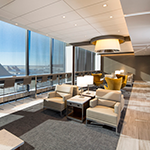The average American office worker fights horrible traffic each morning before arriving at a concrete and steel high-rise filled with isolating, boxy cubicles and sterile, mazelike corridors.
Imagine instead an accessible and sustainable campus that ties indoor and outdoor spaces together while promoting collaboration. That’s the vision for Element LA, a 12-acre creative-office redevelopment in West Los Angeles, overseen by Hudson Pacific Properties.
Hudson Pacific is a real estate investment trust that had a $218 million IPO in June 2010 and started acquiring Hollywood and West Los Angeles properties to grow its portfolio, which already included Sunset Gower and Sunset Bronson Studios. In the past three years, the company, which specializes in the entertainment and tech industries, has gone from holdings of 1.8 million square feet to more than 6 million. Now, its sights are set on changing the landscape of West LA’s concrete jungle.

“We wanted to take it to the next level and build a unique space where creative projects can be born.”
Christopher Barton
Executive VP of Operations and Development
After previous developers gave up on their plans for the 12-acre industrial site at Olympic and Bundy, Hudson Pacific saw an opportunity to transform the vacant land into a buzzing creative community that would attract tenants from entertainment as well as the area’s emerging tech hub, known as “Silicon Beach.” The company acquired the land for $89 million in September 2012 and set out to join detached buildings in order to reposition the tract as a connected campus of single-story offices. “What you usually see in creative offices is the conversion of old, small, industrial buildings,” says Christopher Barton, executive vice president of operations and development at Hudson Pacific. “We wanted to take it to the next level and build a unique space where creative projects can be born.”

While creative offices are usually less than 40,000 square feet, Element LA has a single building spanning more than 155,000 square feet (and the site’s four buildings in total comprise 241,000 square feet). A comprehensive plan for the spaces, conceived by the renowned architecture firm Gensler, provides what tenants in the media, technology, and entertainment industries are looking for in a work environment. Pedestrian paths and a central activity park help unite the sprawling campus, and private patios and shaded outdoor workspaces—accessed via large roll-up glass panels—foster collaboration. “The idea with Element LA is to build an environment totally different from a standard office complex, an environment where people want to work,” Barton says. Other features—such as a parking structure with outdoor event space, a bike shop, cafés, lockers and showers, and full-size volleyball and basketball courts—make Element LA like no other creative-office project around.
“The idea with Element LA is to build an environment totally different from a standard office complex, an environment where people want to work.”
Christopher Barton
Executive VP of Operations and Development
With a redevelopment budget of approximately $60 million, Barton and his team are working quickly to complete the project. Major items on their to-do list include the partial demolition and reconstruction of one existing structure and the construction of all-new systems and infrastructure elements, from exterior curtain walls to roofs to the center promenade. West LA is dense with adjacent multistory properties such as the Colorado Center and the Water Garden. Hudson Pacific’s strategy flies in the face of these freeway-adjacent suburban office complexes with their towering buildings and subterranean parking. “We felt like we could get our returns without rebuilding the property to high density,” Barton says. “Redevelopment will allow us to bring this to the market much faster.”
Barton and his team are eyeing a summer 2014 opening date. The campus’s structures will include the Olympic building (155,350 square feet of rentable office space), 1933 Bundy, (33,550 square feet), 1925 Bundy (20,500 square feet), and 1901 Bundy (29,800 square feet).
With the project moving full speed ahead, Barton and his partners remain confident that they’ll attract a community of creatives to Element LA. “There is a paradigm shift in the industry,” he says. “As companies bring in young talent, they push innovation forward. These new creatives want something different than your father’s office building.”







